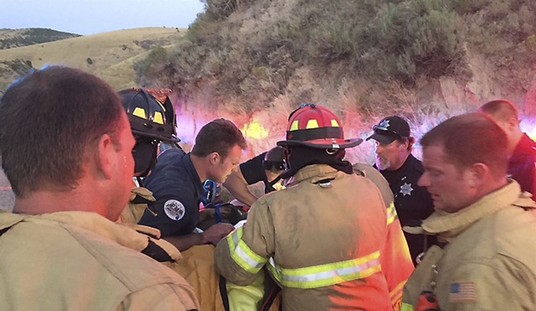We’ve already written several items on the recently requested Authorization for the Use of Military Force and noted how people on both the Left and Right seem to have problems with it, albeit for wildly differing reasons. The uneasiness I felt upon hearing the complaints coming from the port side of the political ship, however, was a bit hard to quantify until I read an opinion piece from Julian Zelizer in CNN this week. In it, Julian lays out many of the standard dove objections which strive to balance the requisite “of course I want to defeat the enemy” platitudes with eager pleas to Democrats to make sure that the restrictions being placed on the President were truly iron clad and we didn’t wind up running off and doing anything too messy.
Fair enough. I’ve objected to a war or two in my time, and I might have come up with some wish list items about how I would see engagements conducted. But the key point here is that this is not a debate over how a war should be conducted. (Any citizen can weigh in on that.) This is an argument over the wording of what the founders would have referred to as a declaration of war. Here’s the crux of Zelizer’s position:
For a start, lawmakers will have to be extraordinarily vigilant in how they word the resolution and make very clear the kind of limits that they want to impose, and to live by. The reality is that even when presidents have promised to use limited force, the nature of foreign conflict has a logic of its own. Pressure can escalate to support intervention…
All this means that when the president sends such a request to Congress, legislators in both parties should take seriously their responsibility to ensure that the language is as tight as possible and that their intentions are clear. They should also use this moment to revisit the 2001 authorization.
This is a bold and well stated position. It also demonstrates a complete failure to either comprehend or recall the duties and limits of the legislative branch in matters of military engagement on foreign soil. Let’s first take a moment and remind Mr. Zelizer as to what the Constitution actually has to say on the subject.
Article I Section 8. The Congress shall have power…
To declare war, grant letters of marque and reprisal, and make rules concerning captures on land and water;
To raise and support armies, but no appropriation of money to that use shall be for a longer term than two years;
To provide and maintain a navy;
To make rules for the government and regulation of the land and naval forces;
To provide for calling forth the militia to execute the laws of the union, suppress insurrections and repel invasions;
To provide for organizing, arming, and disciplining, the militia, and for governing such part of them as may be employed in the service of the United States, reserving to the states respectively, the appointment of the officers, and the authority of training the militia according to the discipline prescribed by Congress;
To put it more bluntly, the Congress has to pay for and structure the military and, when it deems appropriate, to declare that a state of war exists. There are bits of bureaucratic odds and ends if you’re dealing with “the militia” there, but for the most part, they summon the machine of war into existence and fund its ongoing actions. They also unleash the machine when they determine that a state of war exists. But beyond that, the actual decisions about deployment, strategy and tactics is left to the Commander in Chief. As such:
Article II Section 2. The President shall be commander in chief of the Army and Navy of the United States, and of the militia of the several states, when called into the actual service of the United States; he may require the opinion, in writing, of the principal officer in each of the executive departments, upon any subject relating to the duties of their respective offices, and he shall have power to grant reprieves and pardons for offenses against the United States, except in cases of impeachment.
Both Congress and observers thereof might be forgiven for a bit of forgetfulness when it comes to how they declare war, particularly since they haven’t done it in the lifetime of most people reading this. But once again it might assist Mr. Zelizer and others in the choir to recall what Congress actually said the last time they made a true and undeniable declaration of war.
Seventy-Seventh Congress of the United States of America; At the First Session Begun and held at the City of Washington, on Friday, the third day of January, 1942.
JOINT RESOLUTION Declaring That a State of War Exists Between The Government of Germany and the Government and the People of the United States and Making Provisions To Prosecute The Same
Whereas the Government of Germany has formally declared war against the Government and the people of the United States of America: Therefore be it Resolved by the Senate and House of Representatives of the United States of America in Congress assembled, That the state of war between the United States and the Government of Germany which has thus been thrust upon the United States is hereby formally declared; and the President is hereby authorized and directed to employ the entire naval and military forces of the United States and the resources of the Government to carry on war against the Government of Germany; and, to bring the conflict to a successful termination, all of the resources of the country are hereby pledged by the Congress of the United States.
(Signed) Sam Rayburn, Speaker of the House of Representatives
(Signed) H. A. Wallace, Vice President of the United States and President of the Senate
Approved December 11, 1941 3:05 PM E.S.T.
(Signed) Franklin D. Roosevelt[2]
That was it. That was the entire thing. They turned on the war machine and handed it over to FDR. And there was a reason for this, specifically being that this was the extent of their power.
While I might wish for a Commander in Chief with a more clearly developed and enunciated vision as to his strategy for victory and some indication that he intended to carry through with it, you go to war with the President you have, not the President you rejected for having a car elevator. It is not up to the Congress to determine how the war is waged. It is their responsibility to authorize the waging of war on behalf of their constituents. Beyond that point it’s a nice touch to have the President keep top Congressional leaders in the loop, but the job falls on his shoulders. The AUMF does not need to have any limits and specifications as to numbers of troops, the resources to be deployed or the time periods involved. We go to war or we do not… it’s really as simple as that.
Sadly, this seems to be a dusty lesson of history which has been forgotten by the President, the Democrat leadership and Julian Zelizer.








Join the conversation as a VIP Member